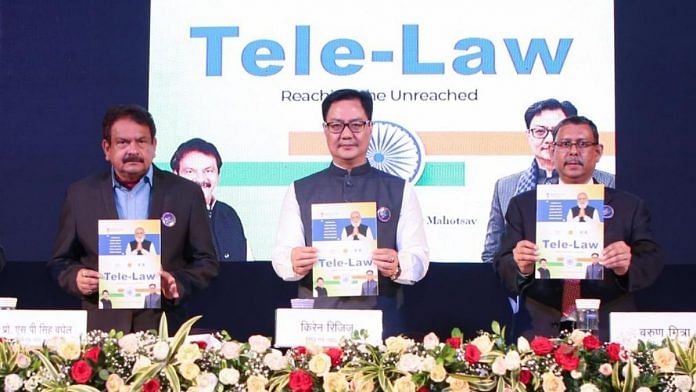New Delhi: When Shikha Srivastava found a toll plaza within a two-kilometre distance from the centre of her village, Nawabganj in Uttar Pradesh’s Unnao, collecting toll tax from four-wheelers despite the rule that those living within a five-kilometre range of the plaza were exempt from payment, she approached a tele-law centre in her district for legal advice and filed a Public Interest Litigation in the Allahabad High Court. The court gave relief not only to her but also to the whole neighbourhood.
Tejiya Devi from Jharkhand’s Giridih district found herself forcibly dispossessed of her land by her relatives. When efforts for amicable resolution led to more ill-treatment, a lawyer empanelled with the local tele-law centre advised her to approach the local registrar’s office to get her land registered — a move that protected her from more harassment.
When Maheshwar Lahajal of Odisha’s Khairpadar village in Kalahandi district was unable to resolve his seven-year-old mutation case, he approached the local tele-law centre for help. The steps he took on the advice of a legal volunteer helped him settle his application in 23 days.
From resolving neighbourhood issues to property disputes, helping overcome procedural hurdles and empowering beneficiaries with information, including on subjects such as the construction of roads, the tele-law service — a pre-litigation mechanism providing online dispute resolution advice at the panchayat level — does it all.
Launched by the Union Ministry of Law and Justice in April 2017, the tele-law service has, as of 1 April 2022, provided legal assistance to more than 16.34 lakh beneficiaries in India’s hinterland.
Women have emerged as the biggest beneficiaries of the service, data collated by the Department of Justice, accessed by ThePrint, shows. More than 4.66 lakh women — 31.31 per cent of all users of the service — have received advice on a host of issues, from domestic issues and Covid-related problems to even those things that have had a bearing on their families.
Of the total beneficiaries, 27.91 per cent come under Scheduled Castes, 19.15 per cent from the Scheduled Tribes and 30.42 per cent from Other Backward Classes (OBC).
“The fact that women constitute 31.31 per cent and overtake all the other categories is evidence that they are increasingly seeking answers and ready to avail legal remedy to settle a dispute,” a senior officer from the Union Ministry of Law and Justice told ThePrint.
The officer recalled an incident of a woman approaching the tele-law service after her family forced her daughter to stop attending school over harassment from a few local boys.
“She registered a complaint with the local police on the advice of tele-law service and the matter was looked into,” he added.
The most widely covered disputes in which advice has been given are entitlement-related cases — an umbrella term that covers subjects that are personal and procedural in nature, such as applications for disability certificates and activation of bank accounts — with more than 10 lakh cases documented under this category.
Land disputes, tenancy, property and inheritance rights accounted for a little over 1.5 lakh cases, while 66,506 criminal matters such as arrests, bail and registration of FIR were dealt with by the tele-law services. There were 72,202 cases related to family disputes and successions, while only 33,978 were related to child labour, education, and child sexual abuse.
Also read: CJI Ramana calls for creation of autonomous body to bring central agencies under one roof
Scaling up
The tele-law services began with an objective to mainstream legal aid through technology. From 1,800 common service centres (CSC) set up initially in 170 districts in 11 states — most of these in Bihar and Uttar Pradesh — the project was scaled up in September 2019 to extend to 117 “aspirational districts” in the country, and the number of CSCs was increased to 29,860.
The facility has been made accessible to the citizens via video conferencing or telephone, available at CSCs, where people get direct access to the empanelled lawyers for pre-litigation advice and consultation.
The government of India considers an “aspirational district” as one that lags in several indicators such as health and nutrition, education, agriculture and water resources, financial inclusion and skill development, and basic Infrastructure — all parameters that have an impact on the Human Development Index.
For such districts, the government of India has appointed ‘prabhari (in-charge) officers’, who must ensure that all central government welfare programmes reach the beneficiaries.
In March 2020, the number of CSCs was further increased to 50,000, and in March 2021, to 75,000. By April 2022, the Ministry of Law aspires to cover all 733 districts in India, and aims to set up one lakh CSCs.
The Department of Justice under the ministry is now also looking to follow up on the outcome of the advice rendered through the tele-law service. For this, the department will soon sign a memorandum of association with the national legal aid body — NALSA — under which an empanelled lawyer from the legal services authority shall be appointed for each district.
“This month, we would be able to cover all the districts in the country. The agreement with NALSA will help us get a dedicated lawyer for each district, which will make it easy for the lawyer to keep a track of the action taken over the advice he or she gave,” another officer associated with the project told ThePrint.
(Edited by Uttara Ramaswamy)
Also read: Incentivise legal aid, give it weightage in selecting ‘senior’ advocates: SC Justice UU Lalit



